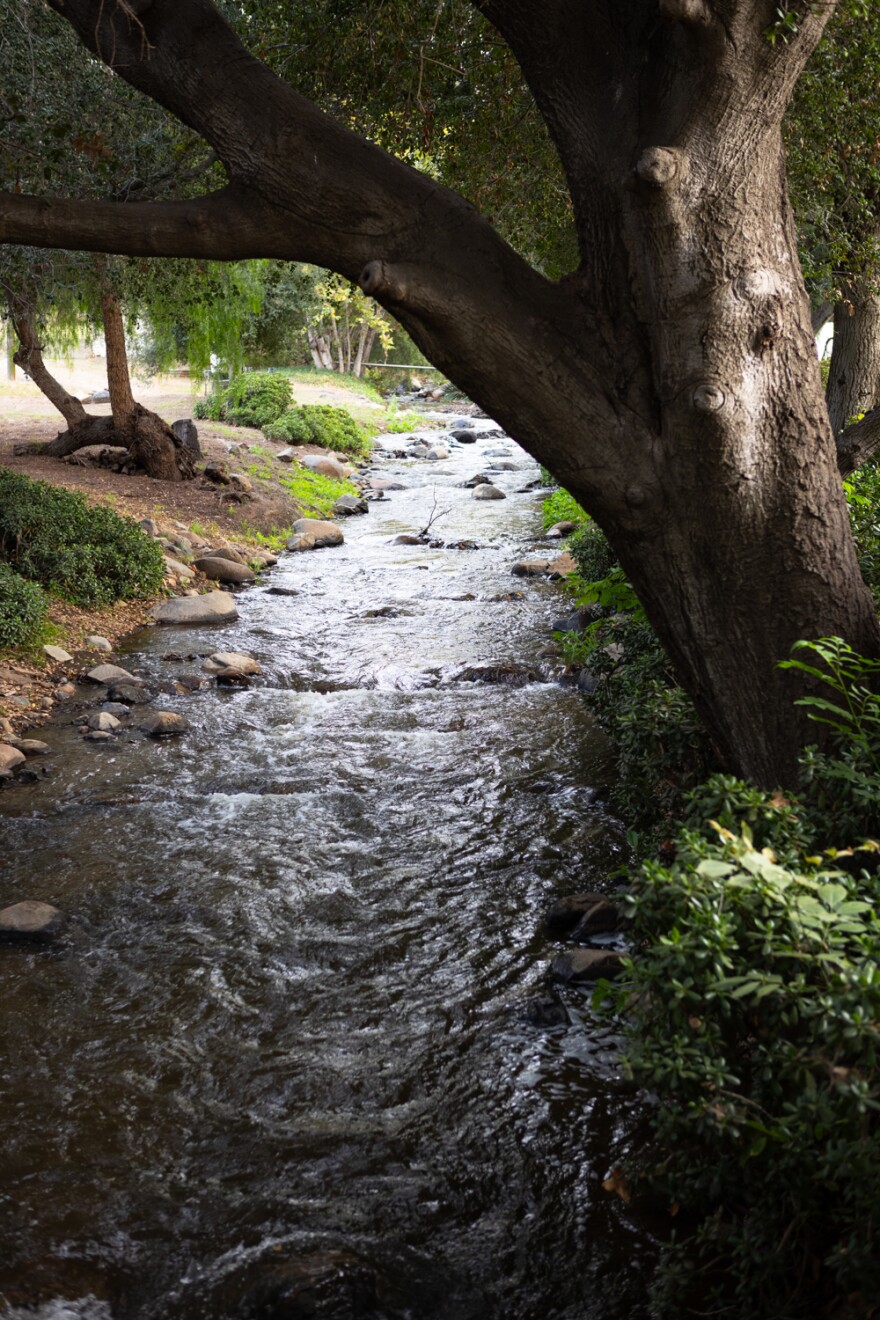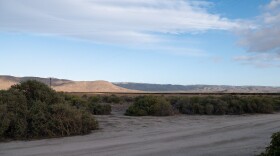Grant Spotts’ family came to Dulzura in the 1880s, searching for water and a home in the rural southeast San Diego County community.
After nearly 150 years, the well on their property continues to deliver.
But around them, Dulzura has transformed in other ways, said Spotts, who owns and operates Dulzura Vineyard & Winery on his family’s land.
“It used to be that you barely saw a truck,” he said. “But things change.”
Once peaceful, starry night skies have become less so. State Route 94, formerly a stagecoach road connecting San Diego to Arizona, has become a congested commuter highway. The bustle and drum of the city has slowly crept into Dulzura, whose name translates to “sweetness” in Spanish.
Now, though, something is coming that could quicken the pace of those changes and threaten the country town’s idyllic character.
The U.S. Border Patrol is building a new station in Dulzura, and it’s bringing with it a significant footprint. It will staff up to 400 employees and house up to 130 detainees. Features include a helipad, fuel island, car washing station and dog kennels. And it will serve as the command and control center for a vast surveillance network covering San Diego’s border region.

The new Brown Field Station will replace an aging station in Otay Mesa and provide “much-needed facilities, technologies, and other infrastructure,” a CBP spokesperson said in an email.
It’s a trade-off for residents. Though they have mixed feelings about the project and how it could change their small town’s way of life, they want and appreciate having Border Patrol in the community.
Only 10 miles from the U.S.-Mexico border, Dulzura is often the first town migrants encounter in a dayslong journey after crossing into the country through a large gap in the border wall.
Residents see Border Patrol as a necessary response to undocumented migration.
Many of Border Patrol’s more than 230,000 encounters in the San Diego Sector in 2023 happened in the enforcement zone containing Dulzura.
The station represents an often overlooked consequence of increasing immigration enforcement: how the expansion of that enforcement changes the look and feel of communities across the U.S.
“We’re not gonna be Dulzura anymore,” said Lance Hafen, who owns Valentina Vineyards and Winery, and whose grapes grow on several acres of land adjacent to the new station. “We’re gonna be Brown Field Border Patrol Station, because it's gonna change the feel and everything in the community.”
The new station is set to be completed in June 2024, four years behind schedule.
“As CBP moves toward completion of the new station, it will continue to strive for a facility that supports effective border security while balancing the needs of the surrounding border community,” the spokesperson said.
A ‘surprise’ to residents
At the site of the new station, heavy machinery grinds away. A tan and green building stands in the center of the rolling hills, surrounded by metal storage containers, chain link fencing and orange construction cones.
A half-mile up the road, the town center rests on a short but winding stretch of the 94. In the afternoons, residents stop by the smallest post office in southern California to pick up their mail, chat with neighbors or grab a drink from the mini market on their way back home.


Residents are mostly optimistic about the new station, even though they’ve raised concerns for years as federal officials moved forward with the project.
First discussed at a community planning meeting in 2017, locals cited possible congestion on the 94, light and noise pollution and increased demand on groundwater systems, which feed the private wells that are Dulzura residents’ sole source of drinking water. They also said there was
little notice given to residents.
But the federal government had already purchased the land — about 120 acres — the year before for $650,000 from a private property owner.
“It was a surprise. They didn’t announce it to nobody here in the community. They didn’t bring it up to the community at all,” said José Hernandez, owner of the Dulzura Mini Market in the center of town. “They just bought the property and then they started developing their buildings back there.”
CBP did not respond to residents’ specific concerns but said the agency “complied with all governing rules and regulations to include periods of public notice and review.”
Locals say the 94 has transformed from a little country road into a rush hour nightmare in recent years. The road, with its narrow, winding lanes, has a reputation for being dangerous, too.
There’s a saying among residents in communities nestled in the area: “Pray for me — I drive Highway 94.”

Residents worry more cars on the road could mean more congestion and more accidents.
The California Department of Transportation is requiring CBP to make safety changes to the roadway directly in front of the station, including acceleration and deceleration lanes and a dedicated left turn lane for the eastbound 94.
A well study conducted by CBP found the station’s demand for water — nearly 4,300 gallons per day — would “have little long term impact on the aquifer.” Over five years, in the worst-case scenario, the aquifer would drop 45 feet, or 5.8%, the agency reported.
Paul Dierkop, a well drilling expert in San Diego County who's been in the business for 30 years, said the water demand from the station is reasonable, adding that agriculture has a much higher demand.

Residents also wonder how noise and light pollution and the physical footprint of the station could affect Dulzura’s quiet character and wildlife. The construction site was previously an agricultural preserve home to threatened or endangered plant and animal life.
The California Department of Fish and Wildlife deemed the site to be of “very high” conservation value for its positioning – surrounded on nearly all sides by nature preserves and managed wildlife areas.
The land was once subject to several local and state policies aimed at protecting natural resources, including the California Land Conservation Act. But that regulation was nullified when the federal government bought the property, according to the environmental report.
And CBP determined the station would fall in line with several more county-level policies for rural and agricultural land preservation and wetland protection.
A welcome presence
A less noticeable impact of the station has wider-reaching implications.
The new Brown Field Station will house the command and control center for a vast network of surveillance equipment spanning San Diego’s coastline and border region, according to planning documents.
CBP’s newest surveillance towers are equipped with radar and capable of infrared and video recording. They are controlled by artificial intelligence to identify moving objects and track them as they move throughout a region.
Migrants from all over the world frequently cross into the U.S. through Marron Valley, a hilly, shrub-filled region on the border directly south of Dulzura. Traces of human travel — discarded clothes, a diaper, empty water bottles, a passport — litter the ground along a dirt road leading from the wall into town.
But, the surveillance technology will capture more than just migrants crossing into the country, according to Dave Maass, director of investigations at the Electronic Frontier Foundation, a digital privacy nonprofit.
“There are going to be these cameras that are capturing vehicles and people and anybody hiking down there, driving down there, people living down there, as well as border crossers,” Maass said.
On a Saturday afternoon in December, a family of five Peruvians, including two young children, sat on a clearing along the dirt road near the border.
They said they wanted to turn themselves in but had already been walking for days. They hoped Border Patrol agents would find them.
One woman in the group asked: “¿A qué hora viene la migra?” What time does Border Patrol come?
Residents have complained of migrants passing through their properties at night, sometimes damaging fences and water pipes or leaving behind trash and waste.
Though they said those run-ins happen less often now, they’re still concerned when they do happen and feel Border Patrol has been responsive to those concerns.
Hernandez, who owns the mini market, says migrants sometimes come by the store, buy food or water and continue on their way.
He’s among those looking forward to the new station. It could mean more business at the mini market, where Border Patrol agents already are among his most frequent customers, next to sheriff’s deputies and fire personnel.

From that side of town, one can hardly see the new station. To others, though, the station’s footprint is already showing. From the Dulzura Winery tasting room, an industrial communications tower at the Border Patrol station peeks above the trees, standing against an otherwise natural skyline.
It bothers Spotts, though he, too, is in favor of the station. He said change in Dulzura is inevitable, and they would be “overrun” without the Border Patrol. But he hopes the agency can paint the tower sky blue.
“Could they have chosen a better site?” he asks. “I don't know, probably could've.”
-
First, we give you a peek into San Diego Mayor Todd Gloria’s State of the City address. Then, Rady Children’s Hospital is challenging a vote by its frontline workers to unionize. Next, the controversy surrounding the San Diego Rodeo happening this weekend. Also, we tell you what ban might come after the latest ban on plastic bags. As well as, an opera designed for kids and other weekend event ideas.
-
We hear how Liberty Station transformed from a Naval Training Center into a cultural hub. Then, we preview a documentary showing at the San Diego Jewish Film Festival. And finally, a sneak peek of "The Finest" podcast's second season.










